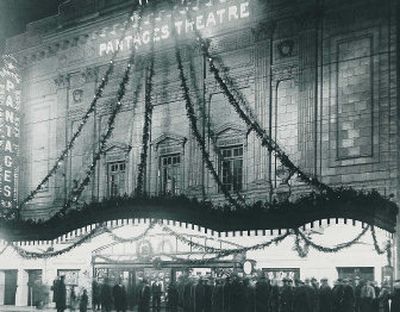Vaudeville central

In 1913, a troupe of vaudeville performers, booked for the week into the Orpheum Theater in Spokane, gave a spur-of-the-moment Fourth of July show in the dining room of their Spokane hotel. They sang, “Oh, Dream Man,” performed impromptu sketches and did “imitations of drunken husbands.” The Spokane Chronicle ran a long list of the names involved. Three jump right out: Will Rogers, Eddie Cantor and George Jessel. Rogers was already a headliner; the other two were still unknown. Cantor was 21, and Jessel was a child comic of only 15. Yet before long, all three would be among the biggest stars in vaudeville.
Big names were not unusual for Spokane, which has a surprisingly rich vaudeville history. From the 1890s into the 1920s, Spokane was a major stop on two of the big vaudeville circuits of the time, the Pantages circuit and the Sullivan and Considine circuit.
Nearly every vaudeville star (or future star) came through Spokane, including Al Jolson, Bob Hope, Burns and Allen, Cornelia Otis Skinner and Jack Dempsey. Yes, even sports figures could make a good living on the vaudeville circuit in those days.
Why did Spokane get all of these top acts?
For one thing, it was considered a “tryout town” for the Pantages circuit.
“If an act made a hit here, it was good for 42 weeks anywhere,” said a former Orpheum manager. “Spokane people ‘sat on their hands’ in those days, and it took a good act to win applause.”
Yet the main reason is simply that the vaudeville circuit was indeed a circuit. Spokane was a major Northwest stop, along with Portland, Seattle and Butte.
Spokane may have even enjoyed a special status on the Sullivan and Considine circuit, because John W. Considine knew it so well. Around 1899, Considine ran the People’s Theater, an early Spokane vaudeville house, before moving on and starting his national chain with Big Tim Sullivan, a Tammany Hall politician in New York. This circuit helped bring Al Jolson and Charlie Chaplin to national attention, among others.
The theater scene in Spokane (and around the country) was divided into many niches through the first quarter of the 20th century. On the high end were the “legitimate” theaters, meaning road shows of actual plays such as “Ben Hur,” at the Auditorium and others. On the low end were many “variety” theaters, later to be called “burlesque” theaters, which catered to crowds of drunken men and gave rise to the art form called the “striptease.”
Vaudeville occupied the vast middle, appealing to a family audience. In 1913, Spokane’s big vaudeville theaters were the Orpheum, the Pantages, the Empress, the Casino and the Clem.
“Everybody came to the theater then,” said Irene Gilmore, who worked in the Sullivan and Considine office in Spokane, in a 1958 interview. “Those were grand days. You could get a box seat for 50 cents or a balcony seat for 15 cents. It was a big occasion, going to the theater.”
That mass appeal explains why a family act such as “Gus Edwards’s Kid Kabaret” (subtitled, “A Kompany of 20 Klever Komiks”) was the headliner at Spokane’s Orpheum in July 1913, even above “Will Rogers, The Oklahoma Cowboy.”
A Spokane Chronicle reviewer noted that Cantor, “in blackface, is an able juvenile comedian.” Jessel, another of the Klever Komiks, was not mentioned.
As for Rogers, the reviewer wrote, “his educated lariats are as lithely curious in their convolutions as ever, while that dry and droll line of patter is actually improving.”
The best show, no doubt, was delivered on the Fourth of July in the New Madison Hotel dining room – the show they put on for themselves.
The Lewis and Clark Report: 200 years ago this week, the Lewis and Clark expedition made dugout canoes and started down the Clearwater River to its junction with the Snake. One canoe sunk, but was recovered and repaired.
Meanwhile at camp, an Indian woman “feigned” madness, according to William Clark. When an expedition member refused a gift of roots and bracelets, she took a sharp flint and cut herself in many places on her arm. Then she scraped the blood into her hand and ate it, and then “went into a fit.” When water was tossed upon her, she came to.
100 years ago in Spokane: A Baptist minister in Spokane delivered a fiery sermon against his city’s liquor, gambling and prostitution.
“We have in our city, along with many better things, a combination of slop, smell, sin, soaks and sorrow; rum, rags and rot; debauchery and death,” he thundered. “… And the mayor says that this is what the people voted for and it is what they want. God pity us: Is it so?”
Meanwhile, a “well-known old-time resident” issued a police complaint that underscored the blatant racism of 1905. He reported that he was set upon by “five Japs and a white bulldog.”
He was eating lunch at Japanese Cafe, when he claimed to be given a “sour” potato. When he complained, he and the cook had words. The “lantern-pawed rice eaters,” as he called them, threw him out on the street. Five of them, plus the dog, then attacked him.
“I could have managed the Japs all right,” he bragged. “But the beast was cunning.”
He was described as “much ate up.”